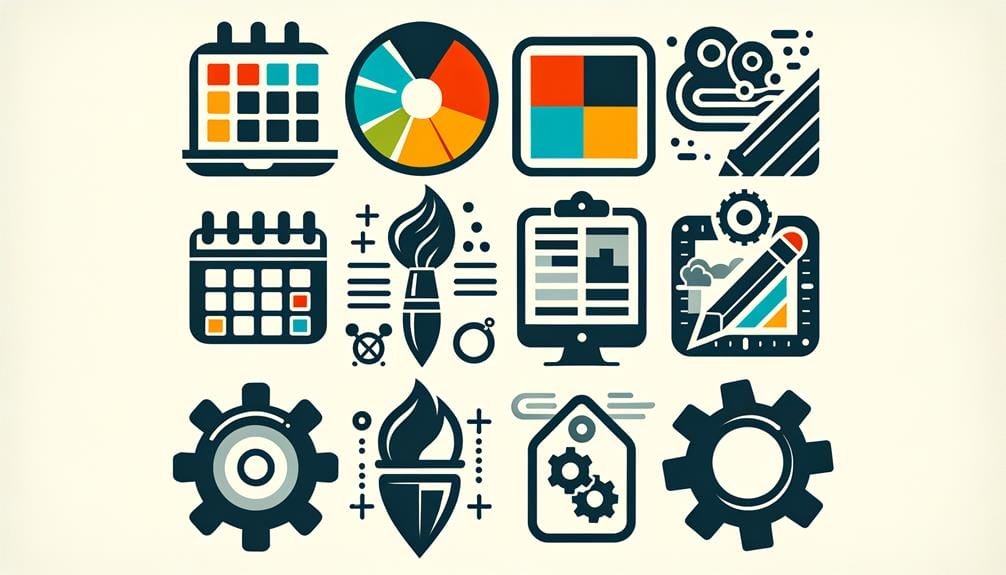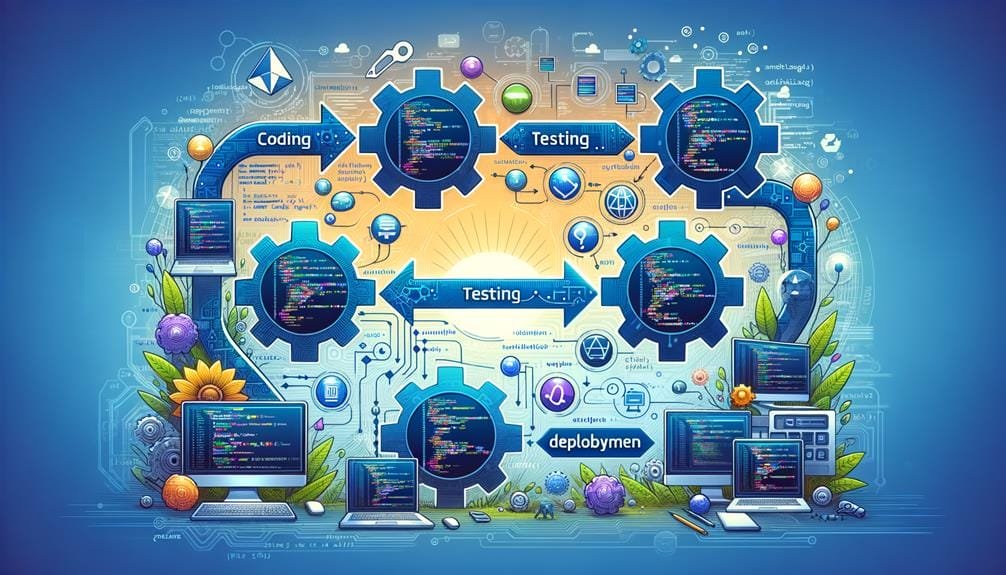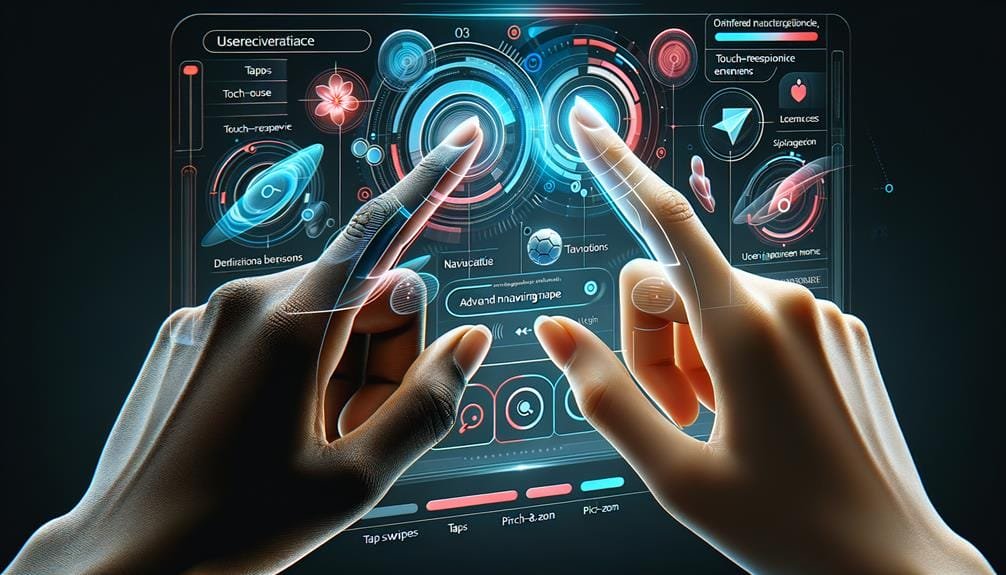Our Newsletter
Sign up for our e-mail newsletter and stay informed for what’s next on the horizon.
In our interconnected era, application software is as crucial as the oxygen we inhale, fueling everything from our handheld devices to our workplaces.
We refer to those programs we frequently use, such as text editors, data organizers, and even your top-choice social networking apps. However, are we fully aware of how they operate, or the possibilities they carry for reshaping our existence?
Join us as we delve into the core of our digital existence, revealing the secrets behind these critical tools, and maybe encouraging you to perceive your regular applications from a fresh perspective.
Delving further into the realm of application software, it’s evident that its potential is vast and largely unexplored.
It isn’t solely about efficiency and productivity anymore. By introducing AI and cloud technologies, we’re on the brink of a monumental shift in how we engage with and use software.
Certainly, the future of application software seems promising. Let’s continue to explore, understand, and utilize these advancements to their full potential.
We’re set to begin our conversation on application software, a fundamental element of our digital universe.
To start, we’ll describe application software and mention its key role in executing specific tasks designed for users.
Gradually, we’ll review the progression of application software and distinguish it from system software, facilitating a thorough grasp of its distinct features and significance.
Exploring the sphere of information technology, application software surfaces as a crucial instrument designed to carry out user commands and simplify tasks, improving productivity and offering personalization options. In contrast to system software, which oversees internal computer operations, application software is user-focused, emphasizing task completion.
To offer a clearer image, let’s employ the following chart:
| Application Software | User Interaction | Task Execution |
|---|---|---|
| Word Processor | High | Writing and Editing Text |
| Spreadsheet | High | Data Organization & Calculation |
| Database Management | High | Data Storing & Retrieving |
Fundamentally, application software serves as a connection between the user and system, aiding task completion and encouraging flexibility in personalization. Its development, though not our main concern, has dramatically transformed the way we engage with technology.
Over time, application software has remarkably advanced, transitioning from basic job-specific applications to multifaceted instruments that boost productivity, advance communication, and protect user information. It’s now competent in instructing computers to carry out intricate operations, catering to user demands across a variety of sectors.
Progress has streamlined processes and boosted team cooperation, making us more effective and interconnected. The advent of cloud-based applications provides us the liberty to access our tasks from any place, eliminating geographical constraints. Moreover, the incorporation of artificial intelligence automates mundane tasks, creating more room for strategic work.
As it progresses, application software consistently focuses on the protection of our data, adapting to emerging cybersecurity threats. The advancement of application software is truly a reflection of our persistent quest for betterment.
When observing the intricate sphere of software, we encounter two principal classifications: application software, tailored to implement specific tasks for users, and system software, created to regulate the computer’s internal mechanisms. The divergence between application software and system software is rooted in their fundamental roles. While application software programs are designed to serve specific tasks for users, system software is created to control internal computer mechanisms.
| Types of Application | Application Software | System Software |
|---|---|---|
| Word Processor | Yes | No |
| Spreadsheet | Yes | No |
| Database Management | Yes | No |
| Operating System | No | Yes |
This defining difference aids our comprehension of their functions and significance within the digital environment.

Proceeding further, let’s delve into the diverse types of application software, commencing with productivity software, web browsers, and multimedia software.
We’ll also touch upon communication and educational software, providing us a thorough insight into this extensive field. Each category has a distinct role in optimizing our daily activities, improving our digital adventures, and fostering connections in our progressively interconnected world.
Continuing our dialogue on application software, we now turn our attention to productivity software, an important element of this group.
Specifically, we’re going to look at Office Suites and Personal Management software, both integral to improving user performance. These tools, with their unique capabilities, not only simplify processes but also aid in better organization and output quality.
Delving into the sphere of productivity software, office suites emerge as comprehensive solutions, providing a variety of applications such as word processors, spreadsheets, and presentation tools, crucial for boosting productivity across a wide range of industries.
Leading entities like Microsoft Office, Google Workspace, and Apple iWork control the market. Their sophisticated features and integrative capabilities allow us the liberty to tailor, cooperate, and generate, stimulating efficiency and novelty in our routine tasks.
In the sphere of efficiency software, we come across personal management applications, a multi-use toolkit that enables individuals to neatly arrange tasks, timelines, and personal details.
Hence, personal management software substantially improves productivity by offering a structured method for handling tasks, timelines, and contacts.
Transitioning to the subject of internet browsers, which are a form of application software, we’ll examine the unique attributes and operations that distinguish them.
We’ll also assist you in selecting the most suitable internet browser based on your particular requirements and likes.
Comprehending these elements is vital for effectively using and moving through the online environment.
Commonly utilized for internet browsing, web browsers are a category of application software that fetches and displays data from the web via protocols, such as HTTP. They make possible user interaction with online services and web applications.
In the process of determining the best web browser, we need to look at various aspects.
The existence of add-ons amplifies their capabilities, while personalization features enable customization.
Web browsers, including Google Chrome, Mozilla Firefox, Safari, and Microsoft Edge, differ in their capabilities to exhibit multimedia content and access online services.
Thus, the decision of the optimal browser is influenced by individual requirements and tastes.
Now, we shift our focus to multimedia software, a critical classification within the broader scope of application software.
This group involves essential tools utilized in graphic design, as well as software for video editing and playback.
Reviewing these tools, their functionality, and their influence on various industries is fundamental to our comprehension of the extensive abilities of application software.
Within the wide range of application software, graphic design tools are vital in the professional sphere of graphic designers, artists, and marketers. These tools equip them with the ability to shape visual designs using elements such as bitmap and vector graphics.
The rise of multimedia software has also given way to the development of video editing and playback software, another crucial element in our digital toolbox.
Video editing software gives us access to a wide range of editing features, while playback software offers the necessary control over video playback.
These instruments, which fall under the larger umbrella of multimedia software, allow us to create, modify, and appreciate content, thus enhancing our digital experience.
Let’s now turn our attention to another crucial type of application software – communication software.
We’ll look at two main categories: email and instant messaging, along with collaboration platforms.
These tools are indispensable in the current digital age, promoting swift and direct exchange of information and improving collaboration among users.
Within the domain of application software, email and instant messaging systems are critical communication resources, facilitating the electronic transmission of messages, documents, and multimedia in real-time.
We note:
Looking at collaborative tools such as Slack, Microsoft Teams, and Zoom, we see that they serve as potent communication applications created to simplify team dialogue and boost immediate teamwork. They play a significant role in increasing work efficiency and facilitating continuous communication via mobile apps.
| Platform | Key Feature |
|---|---|
| Slack | Chat Channels |
| Teams | Task Management |
| Zoom | Video Conferencing |
Their impressive capabilities render them indispensable in the current digital work environment.
In our exploration of application software, we now focus on educational software. This class of software, encompassing e-learning platforms and interactive learning tools, is crafted to improve the learning journey.
We’ll examine the complexities of these systems, placing emphasis on their design, operation, and influence on personalized learning.
Venturing into the sphere of educational software, we encounter e-learning platforms, a specific type of application software designed to enable online learning and training. These engaging platforms provide:
They represent liberty, accommodating various learning styles and enriching the overall educational experience.
Building upon the idea of online learning platforms, our focus now shifts to interactive learning tools, a specific sub-category within educational software applications. These provide interactive learning experiences through simulations, tracking of progress, and content using multiple media. Let’s delve deeper into this aspect.
| Educational Software | Key Features | Example |
|---|---|---|
| Interactive Learning Tools | Simulations, Tracking of Progress | Khan Academy |
| Content Using Multiple Media | Duolingo | |
| Interactive Learning Experiences | Rosetta Stone |

In grasping application software development, we’ll first explore the Software Development Life Cycle (SDLC), an essential framework outlining the steps involved in the creation and ongoing upkeep of software.
We’ll also assess the various programming languages and tools utilized in building application software, underlining how these diverse technologies contribute to the functionality and user experience of the final product.
Lastly, we’ll review contemporary software development methodologies, like Agile or DevOps, that significantly impact the pace, collaboration, and adaptability of the development process.
In understanding the production of application software, it’s key to become acquainted with the basics of the Software Development Life Cycle (SDLC), a procedural process that encompasses everything from start to finish. The SDLC is an all-inclusive structure, ensuring that all tasks – from planning, design, coding, to testing, are carried out with precision for quality and efficiency.
Grasping the SDLC empowers us, providing a navigational chart that directs us to produce durable, top-tier software that satisfies user requirements and business goals.
In the field of software development for applications, programming languages and tools play a key role.
We’ll initiate by analyzing prevalent languages such as Java, Python, and C++, which are the pillars of the majority of software applications.
Subsequently, we’ll shift our attention to development environments and Integrated Development Environments (IDEs), fundamental components that streamline the process of coding, debugging, and testing.
Venturing into the field of application software creation, we encounter prominent programming languages such as Java, Python, JavaScript, C++, and Swift at the heart of this complex operation.
Often, we employ Development Environments and Integrated Development Environments (IDEs) to facilitate our software creation process. They provide a comprehensive solution for coding, debugging, and testing.
Equipped with features such as code auto-fill, syntax illumination, and version control integration, IDEs improve our productivity. By supporting a range of programming languages, these development platforms give us the flexibility to select the most appropriate tools for our assignments.
Concentrating on contemporary software development methodologies, we’ll initially discuss the differences between Agile and Waterfall. Appreciating these techniques is essential for understanding their influence on the process of building and refining application software.
Subsequently, we’ll examine the application of DevOps practices and their significance in smoothing and automating the progression of development.
In the sphere of application software creation, two dominant methodologies are prominent: Agile and Waterfall, each possessing unique strategies for overseeing project advancement and addressing user needs.
Turning our attention to DevOps practices, we recognize these techniques are aimed at promoting collaboration between development and operations teams, with the primary objective of automating and improving the entire software development process. By incorporating continuous integration, we reduce errors, ensuring a smoother, more efficient workflow.
| DevOps Practices | Purpose | Tools |
|---|---|---|
| Collaboration | Simplify workflows | Slack, Jira |
| Automation | Boost efficiency | Jenkins, Ansible |
| Continuous Integration | Minimize errors | Travis CI, CircleCI |

We’re now focusing on the interplay between operating systems and application software.
We’ll talk about the difficulties of ensuring compatibility among diverse systems and applications, provide insight into the most widely used operating systems, and scrutinize the intricacies of developing software that works across multiple platforms.
This vital relationship determines user experience and system efficiency, necessitating thoughtful planning and resilient solutions.
Dealing with the compatibility challenges between operating systems and application software often presents a complex terrain, as variations in system requirements, versions, and dependencies can lead to significant issues. Compatibility problems may surface when operating system upgrades make existing application software obsolete or non-functional. Furthermore, some application software may not be designed for newer operating systems, leading to operational complications and possible errors. Hence, carrying out compatibility testing is a crucial step in ensuring smooth integration between operating systems and application software.
Now, we shift our focus to well-known operating systems, a vital component of application software.
This includes Windows, macOS, and Linux for desktop computers, along with Android and iOS for mobile gadgets.
Each operating system presents unique features and interfaces, impacting software compatibility, the user experience, and the total effectiveness of application software.
Exploring popular operating systems, Windows, macOS, and Linux each offer unique advantages and are compatible with various application software, shaping user experience and productivity across different industries.
Windows is widely appreciated for its user-friendly interface. macOS is highly praised among creative professionals. Linux is known for its adaptability.
When focusing on mobile operating systems, it’s clear that Android and iOS are the leading players, each offering distinct features and abilities to support a broad range of mobile applications. Android is recognized for its adaptability, while iOS receives praise for its security attributes. Both systems have a comprehensive array of apps to meet our varied requirements.
| Android | iOS |
|---|---|
| Most commonly utilized | Apple’s exclusive system |
| High degree of customization | Intuitive interface |
| Adaptable | Robust security measures |
| Compatible with numerous apps | Consistent software updates |
| Options for personalization | Rigorous app approval process |
In the sphere of application software, cross-platform software development rises as a crucial approach, allowing applications to function smoothly across various operating systems like Windows, macOS, and Linux. It’s a method that provides significant efficiencies, removing the requirement for separate development for each platform. Instruments like Xamarin have played a key role in realizing this, simplifying the procedure and conserving both time and resources.
Cross-platform development guarantees a uniform user experience, regardless of the device or operating system. Compatibility testing is a critical stage, ensuring the application works optimally on each platform. The utilization of instruments like Xamarin optimizes the process, making it more efficient.

In the sphere of application software, the aspects of User Interface (UI) and User Experience (UX) hold a significant position. Governed by the standards of efficient UI design, our goal is to develop interfaces that are straightforward, improving the all-inclusive user interaction and involvement.
It’s not simply about looks; it’s about building a space that puts user requirements first, simplifies tasks, and in the end, propels productivity.
As the development of application software progresses, the significance of effective User Interface (UI) and User Experience (UX) design principles shouldn’t be disregarded. These principles aim at crafting instinctive interfaces that markedly improve user interaction and satisfaction.
To attain a successful UI design, our focus should be on:
In boosting user experience through design in application software, there are three key considerations:
By integrating accessibility features into the UI and UX design of application software, we significantly improve the experience for individuals with disabilities. Our attention is directed towards:
Continuing with our dedication to accessible software, we now focus on the importance of personalization and user feedback in improving the user interface (UI) and user experience (UX) design of application software.
Personalization adjusts the UI to meet individual needs, while user feedback structures guide ongoing enhancements in UX design. This partnership nurtures a more engaging, fulfilling user experience, encouraging freedom and uniqueness.
We’ll now focus on the licensing and distribution models of application software. Starting with an understanding of various software licenses like proprietary, open-source, and public domain, we’ll assess their effect on software accessibility and use.
Additionally, we’ll examine the increasing role of subscription models in shaping user interaction and access to software applications.
In our examination of application software, we’ll now address the vital subject of comprehending various license types, particularly concentrating on freeware, shareware, open-source, and commercial software.
These licensing and distribution models not only govern the lawful use of software but also form the manner in which software is disseminated, altered, and monetized.
In the sphere of app software, two primary licensing and distribution models frequently come into view: freeware and shareware.
Grasping these models provides us the authority to decide on software that meets our preferences for autonomy and budgetary limitations.
Venturing into the area of licensing and distribution models, we find two primary categories: open source and commercial software, each offering unique benefits and constraints.
Open source software, constructed on community collaboration, provides freedom in modification and distribution.
Commercial software, conversely, requires a license purchase and often limits alterations.
Grasping these license types is vital to select the software that best meets your freedom requirements.
In recent years, the transition to subscription models for software utilization has profoundly influenced our interaction with application software, altering the licensing and distribution methods in the process. This change has created a move from one-time payments to a system that provides adaptability, giving users the opportunity to pay at regular intervals for software utilization.
The progression towards subscription models has expanded software utilization, making it more cost-effective and available, thus freeing us from the constraints of substantial one-time charges.

Security and privacy serve as fundamental elements in the field of application software.
We’ll talk about the primary security characteristics to seek in these software, such as encryption and verification processes, and the importance of employing safe coding methods.
Additionally, we’ll tackle privacy issues and examine the remedies at hand, like adherence to data safety rules and the significance of consistent security checks.
In the process of selecting application software, it’s crucial to take into account key security attributes such as encryption protocols, secure authentication techniques, and consistent security updates. Encryption protocols serve as a shield for your data during transmission and storage, while authentication techniques like multi-factor authentication obstruct unauthorized access. Consistent security updates ensure your system stays fortified against developing threats.
Additional attributes to think about include:
In addressing privacy concerns within application software, it’s important to focus on data encryption and strong user data safeguarding. This can be accomplished by regular software upgrades and meticulous patch administration.
In the intricate sphere of application software, it’s essential to consider the crucial role of data encryption and user data protection mechanisms. These are key in providing secure transmission and storage of sensitive data, protecting individual details from potential security breaches, and establishing strong privacy policies to reduce privacy issues.
Compliance with data protection regulations is also paramount, demonstrating our dedication to preserving user privacy and liberty.
Safeguarding the integrity and operation of application software is crucial. The significance of software updates and patch management can’t be underplayed. Frequent updates supply required security rectifications and performance improvements.
Efficient patch management averts system susceptibility to online threats and data compromises. To truly relish our autonomy, it’s vital that we arrange updates, meticulously examine patches, and confirm their smooth amalgamation with our existing systems.
Looking forward to the future of application software, several budding trends appear ready to transform the scene.
The most significant among these are the integration of AI and machine learning, offering unmatched capabilities and improved user interfaces.
In addition, the transition towards cloud computing is expected to deliver greater adaptability and expandability, crucial aspects in our swiftly changing digital environment.
As we consider the future of application software development, we see a significant transformation towards applications hosted on the cloud, providing users with improved adaptability and scalability. This evolutionary trajectory establishes the framework for inventive solutions that aren’t only effective but also adapt swiftly to the changing needs of our users.
We’re also noticing:
These trends highlight our passion for autonomy, adaptability, and the pursuit of technical superiority in software development.
Observing these evolving trends, a significant transformation is apparent in the future of application software, particularly with the influential role of AI and machine learning.
AI algorithms are altering the field, enabling predictive analytics and smart automation that simplify tasks and improve decision-making processes. Concurrently, machine learning algorithms learn from abundant data, steadily improving the adaptability and functionality of application software.
This integration isn’t only innovative but a vital competitive edge, fuelling growth in the tech sector. In addition, these progressions are crucial in delivering personalized user experiences, enabling users with the flexibility to tailor and enhance their workflows.
Indeed, the future of application software is closely linked with AI and machine learning.
Transforming the field of application software, cloud computing introduces vast potential by providing unmatched adaptability, expandability, and economic efficiency. We’ve stepped into a new epoch where software has evolved beyond being just a tool – it’s now a service that conforms to our requirements. The adaptability of cloud computing allows us to utilize applications from any location, at any time – a crucial shift for remote work.
Expandability enables us to modify resources based on necessity, resulting in a cost-saving solution. Data protection, a key concern, is tackled by implementing sophisticated encryption and verification measures, thereby protecting sensitive data.
We are heading towards a future of application software where the boundaries between software and service are becoming indistinct, forming a smooth, secure, and liberating user experience. Cloud computing is guiding us towards this future.
Choosing the optimal application software necessitates a thorough examination of our unique requirements and the software’s compatibility with pre-existing systems.
We’re required to assess software on the grounds of its capabilities, the assistance offered by the vendor, and its value for money.
This methodical strategy ensures that we select software that fulfills our immediate needs while also providing the potential for future expansion.
In the broad field of application software, a tactical approach is crucial, starting with the key step of evaluating your specific requirements and making sure the software is compatible with your current systems. We need to consider:
In addition, we mustn’t underestimate the significance of user-friendly interfaces. These make the software simpler to use, allowing us to optimize productivity. Lastly, we must confirm that reliable technical support is available, to tackle any problems we might encounter.
After identifying our needs and compatibility, we move forward with the important process of examining the application software based on criteria such as features, support, and cost to ensure it aligns with our needs.
We closely inspect features like document management, collaboration tools, and data analysis capabilities. Support holds importance for us, as we evaluate the quality of customer service, the availability of training materials, and continuous technical assistance.
The cost isn’t just the initial purchase price, but also includes subscription charges, maintenance expenses, and possible additional costs for upgrades or personalization. We also take into account the software’s scalability, integration with our existing systems, user interface, and simplicity of use.
Judging software vendors based on their reputation, user reviews, and industry recognition offers us an understanding of their dependability and credibility.

Wrapping up, we recap the essential aspects of application software and its indispensable contribution to boosting efficiency and managing data.
The subsequent steps will involve investigating more resources related to cloud-dependent, AI-incorporated, and mobile application software.
This will also require a more profound comprehension of cybersecurity procedures, as they’re vital for safeguarding user data.
In summarizing our discussion on application software, it’s key to note that this kind of software, created to perform specific functions and simplify tasks, greatly improves productivity. From Microsoft Office to Google Chrome and Skype, these are excellent instances of application software that are markedly different from system software.
Here’s a swift review:
To deepen our understanding and improve our competencies in application software, we’ll now delve into additional resources such as online courses, tutorials, and webinars. These platforms provide a wealth of knowledge in advanced topics like application development, software integration, and cloud computing.
By interacting with industry experts, forums, and communities, we can gain useful insights and networking opportunities. Certifications in software development or specific application software can’t only advance our career prospects but also give us the freedom to choose our preferred field.
Moreover, experimenting with different software tools and platforms assists in practical skill development and real-world application. In summation, continuous learning and investigation are vital to mastering application software.
Diving deeper into the world of application software, it’s clear that its potential is extensive and largely untapped.
It isn’t only about efficiency and productivity anymore. By incorporating AI and cloud technologies, we’re on the edge of a significant change in how we interact with and utilize software.
Indeed, the future of application software appears bright. Let’s keep investigating, comprehending, and utilizing these advancements to their maximum potential.
Our conversation focuses on software designed for specific tasks performed by users. Examples include text editing tools like MS Word, data organizing applications like Excel, and visual creation platforms such as Adobe Photoshop. These are crucial in boosting efficiency and promoting creative expression.
The seven categories of software that we’ve pinpointed are: document editing, data organizing tables, slideshow creation, multimedia handling, learning-focused, visual design, and adaptable. Each of these has distinct uses, increasing efficiency and allowing for individual user adjustments in various sectors.
Within system software, an application instructs the computer to execute tasks specific to the user. It is distinct from system software, which governs internal operations. Instead, it improves efficiency by simplifying functions such as word processing or data handling.
We are exploring the three principal types of software: system, application, and programming software. Each contributes a different function in controlling hardware, executing tasks for the user, and assisting with software creation, respectively. They are indispensable for efficient computer operation.
Sign up for our e-mail newsletter and stay informed for what’s next on the horizon.